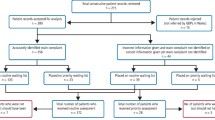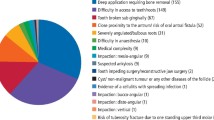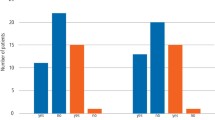Abstract
Introduction The number of children undergoing dental extractions under general anaesthetic (GA) remains high. The newly published Royal College of Surgeons guidelines in 2023 take a less prescriptive approach on balancing and compensating extractions for first permanent molars. In an effort to maintain an effective and efficient patient care pathway, an orthodontic remote assessment triage model was developed in West Dorset for the special care dentistry and community dental service.
Aims The orthodontic triage form is now used across Dorset. This service evaluation assesses whether the form is still effective despite the upscaling. Furthermore, qualitative feedback was obtained from the clinicians involved in referring and triaging.
Design The sample of 352 forms consisted of children aged 16 years or younger undergoing GA for dental extractions for whom orthodontic triage had been requested between March 2019 and March 2023. The clinician feedback was collected using a questionnaire.
Results This service evaluation found that 53.1% of patients had their treatment plan modified following an orthodontic assessment. Positive feedback from all clinicians involved suggests there is potential to expand this model to other services.
Discussion Involving the orthodontist can address orthodontic concerns which has the potential to simplify or obviate the need for future orthodontic treatment. Remote assessment reduces the need for face-to-face appointments. The clinician perspective influences willingness to further develop and expand the current pathway.
Conclusion Remote triage has proved successful in Dorset. There is potential to build an initiative between primary and secondary care in the hopes of creating a universal national proforma to increase access to orthodontic opinions for children requiring dental extractions.
Key points
-
Explains the importance of the orthodontist's opinion in addressing occlusal concerns for children requiring extraction of permanent teeth under general anaesthesia.
-
Demonstrates the benefits to patients and NHS services of a remote orthodontic triage pathway in Dorset.
-
Suggests the value of a remote triage system to be used in multidisciplinary teams in wider NHS dental services and the community.
This is a preview of subscription content, access via your institution
Access options
Subscribe to this journal
Receive 24 print issues and online access
$259.00 per year
only $10.79 per issue
Buy this article
- Purchase on Springer Link
- Instant access to full article PDF
Prices may be subject to local taxes which are calculated during checkout








Similar content being viewed by others
References
Tahir M H, Ellis P E, Hollingsworth L. An email triage model for personalising paediatric permanent tooth extractions under general anaesthesia. Br Dent J 2019;226: 979-984.
Fox F, Whelton H, Johnson O A, Aggarwal V R. Dental extractions under general anesthesia: new insights from process mining. JDR Clin Trans Res 2023; 8: 267-275.
UK Government. Hospital tooth extractions in 0 to 19 year olds 2022. 2023. Available at https://www.gov.uk/government/statistics/hospital-tooth-extractions-in-0-to-19-year-olds-2022/hospital-tooth-extractions-in-0-to-19-year-olds-2022 (accessed June 2023).
NHS England. Getting It Right First Time: Hospital Dentistry National Report. 2021. Available at https://www.gettingitrightfirsttime.co.uk/medical-specialties/hospital-dentistry/ (accessed August 2023).
Royal College of Surgeons of England. Guidance for the extraction of permanent molars in children. 2023. Available at https://www.rcseng.ac.uk/-/media/fds/guidance-for-the-extraction-of-first-permanent-molars-in-children.pdf (accessed June 2023).
Banerjee A, Watson T F. Pickard's Guide to Minimally Invasive Operative Dentistry. Oxford: Oxford University Press, 2015.
Hong L, Levy S M, Warren J J, Broffitt B. Association between enamel hypoplasia and dental caries in primary second molars: a cohort study. Caries Res 2009; 43: 345-353.
Cobourne M, Williams A, Harrison M. National clinical guidelines for the extraction of first permanent molars in children. Br Dent J 2014; 217: 643-648.
Murphy M, Scott L J, Salisbury C et al. Implementation of remote consulting in UK primary care following the COVID-19 pandemic: a mixed-methods longitudinal study. Br J Gen Pract 2021; 71: 166-177.
Montes J, Eichinger K J, Pasternak A, Yochai C, Krosschell K J. A post pandemic roadmap toward remote assessment for neuromuscular disorders: limitations and opportunities. Orphanet J Rare Dis 2022; 17: 5.
Sangalli L, Savoldi F, Dalessandri D et al. Effects of remote digital monitoring on oral hygiene of orthodontic patients: a prospective study. BMC Oral Health2021; 21: 435.
Sangalli L, Savoldi F, Dalessandri D, Visconti L, Massetti F, Bonetti S. Remote digital monitoring during the retention phase of orthodontic treatment: A prospective feasibility study. Korean J Orthod 2022; 52:123-130.
Author information
Authors and Affiliations
Contributions
Hiraa Javed and Pamela Ellis conceived the article. Hiraa Javed collected the data, designed and performed the analysis. Hiraa Javed and Pamela Ellis wrote the article. Lorna Hollingsworth and Rebecca Bradley revised the article.
Corresponding author
Ethics declarations
The authors declare no conflicts of interest. The authors confirm that ethical approval was not required for this project as this was a service evaluation rather than a research study. The purpose of the service evaluation was to measure the appropriateness of the patient pathway and measure its effectiveness against the previous pathway. The project was approved by Dorset County Hospital's Clinical Audit Department (Audit registration number 5857). No interventions on patients were carried out. Patient consent was not required for this service evaluation as the data was reviewed retrospectively and anonymised.
Data availability
The data is not publicly available due to it containing information that could compromise the privacy of patients.
Rights and permissions
Springer Nature or its licensor (e.g. a society or other partner) holds exclusive rights to this article under a publishing agreement with the author(s) or other rightsholder(s); author self-archiving of the accepted manuscript version of this article is solely governed by the terms of such publishing agreement and applicable law.
About this article
Cite this article
Javed, H., Ellis, P., Hollingsworth, L. et al. The value of a remote orthodontic assessment for children having permanent teeth extracted under general anaesthesia. Br Dent J (2024). https://doi.org/10.1038/s41415-024-7351-6
Received:
Revised:
Accepted:
Published:
DOI: https://doi.org/10.1038/s41415-024-7351-6



